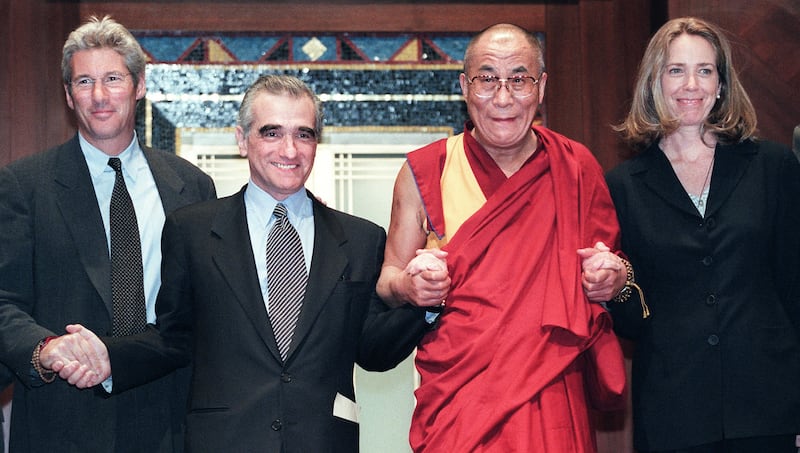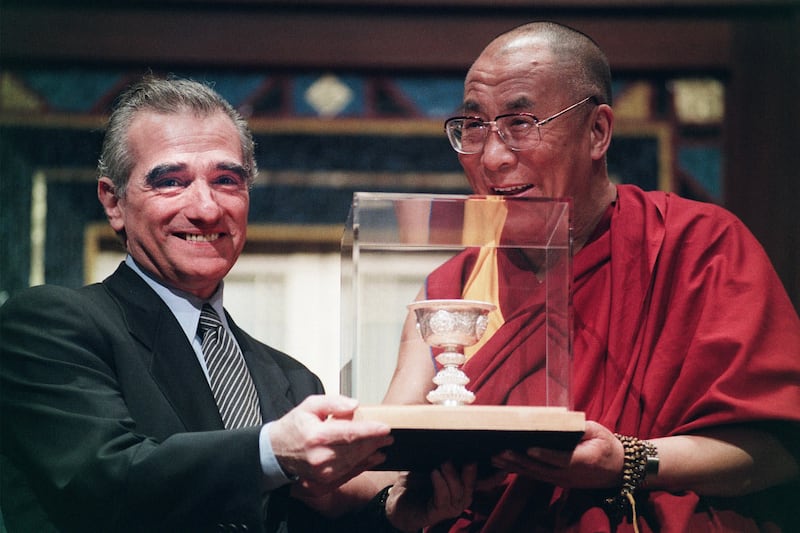NEW YORK — The making of Martin Scorsese’s 1997 Oscar-nominated film Kundun was a “spiritual act” and a “very personal and special project,” the legendary filmmaker said at a rare public screening of the film on the big screen at the Tribeca Festival in New York.
Friday’s screening was part of global celebrations honoring the Dalai Lama’s 90th birthday. Kundun chronicles the early life of the Tibetan spiritual leader, from his discovery as the 14th Dalai Lama as a young child in Tibet to his escape into exile in India at age 23 following the 1959 Tibetan uprising against Chinese rule.
“The experience of making Kundun changed my life for the better in many different ways," Scorsese told the audience at New York’s SVA Theatre, where Kundun — meaning “presence” in Tibetan, a reverent title for the Dalai Lama — screened in its original 35mm format before hundreds of attendees, including Scorsese fans and members of the Tibetan community.
The film represents a dramatic departure from the director’s typical crime epics like Goodfellas (1990) and Casino (1995). Unlike those acclaimed works, Kundun remains largely inaccessible on major streaming platforms, making the screening at Tribeca a coveted experience for film enthusiasts.
“It’s a big blindspot in a filmmaker whose work I have seen most of and is hugely influential in my love for cinema and the work I do,” Giovanni Lago, a New York-based writer and podcaster, told RFA. “For some reason, you can’t find it on streaming apps. You can’t find it online … So to see it on film at Tribeca with Martin Scorsese himself introducing it is just the perfect recipe.”
Following the film’s completion, the Chinese government pressured Disney to shelve the project entirely. While Disney ultimately gave the film a limited Christmas release in 1997, the company’s then-CEO Michael Eisner publicly apologized for the production.
“The bad news is that the film was made; the good news is that nobody watched it,” Eisner said at the time. “I want to apologize, and in the future, we should prevent this sort of thing, which insults our friends, from happening,” he said.
Even today, Kundun is not available on major streaming platforms, including Disney’s own service, Disney+. Disney did not immediately respond to RFA’s request for comment.
“The Chinese government has consistently suppressed all the films about the Dalai Lama produced in the West … because if these films were shown in China, mainland audiences would gain a more genuine understanding of who the Dalai Lama really is,” Kunga Tashi, Tibetan liaison officer at the Washington-based office of Tibet’s government-in-exile, told RFA.

China banned Scorsese, screenwriter Melissa Mathison, and even her then-husband Harrison Ford — who had no direct involvement in the film — from entering the country. This reflected Hollywood’s complex relationship with China, where access to the lucrative Chinese market often trumps artistic expression. Similar bans affected actor Brad Pitt for his role in Seven Years in Tibet (1997) and Richard Gere for his Tibet advocacy.
“Given that China has consistently sought to restrict and suppress the distribution and screening of this film … I believe this screening at the financial capital of the U.S. is a great win for the Tibetan race, and a matter of pride and joy for me as a Tibetan,” Tara Lobsang, a Tibetan entrepreneur and artist based in New York, told RFA.
A spiritual journey
Making Kundun was a profound spiritual journey for Scorsese, a Roman Catholic who a few years earlier courted religious controversy and even faced death threats for The Last Temptation of Christ (1988). Mathison, who wrote the screenplay for Steven Spielberg’s E.T. the Extra-Terrestrial (1982), brought Scorsese the script for Kundun, setting the director on what he described as his own “spiritual exploration.”
“I was really always intrigued by Tibetan Buddhism and the nature of Tibetan culture,” Scorsese reflected. “It seemed very far from my experience. But making films was always, for me, a path to discovery: discovery of new forms of expression ... of different cultures, (and) different ways of existing.”
Scorsese finalized the script with Mathison after consulting with the Dalai Lama himself in a meeting at Mathison’s Wyoming home, emphasizing the project’s authenticity and reverence.
But the film’s production proved as challenging as its subject matter was sensitive for China.

Scorsese, who later traveled to Dharamsala, India, to meet the Dalai Lama again ahead of the making of the film, initially set his sights on shooting the movie in various places in India, but the team ran into a “lot of bureaucracy” and finally settled on Morocco, where Scorsese had shot The Last Temptation of Christ.
Using the Northern Sahara Desert and Atlas Mountains, along with specially constructed sets – to depict the Dalai Lama’s winter and summer palaces, the Potala Palace and the Norbulingka, and the streets of Tibet’s capital Lhasa – the crew painstakingly created a convincing illusion of Tibet in Morocco.
Hundreds of Tibetans, including monks from the Dalai Lama’s Namgyal Monastery and performers from the Tibetan Institute of Performing Arts in Dharamsala, traveled to Morocco, working alongside a multilingual crew who hailed from more than half-a-dozen nations.
“We were dealing with seven languages on set – Tibetan, English, French, Italian, (Hindi), Arabic, and Berber – just to say ‘action.’ But once we got one word down, we figured the rest out,” Scorsese recalled, drawing laughter from the audience at the screening.
The screening at Tribeca marks one of the first events on the Compassion Rising World Tour — a global movement launched by the Washington-based advocacy group International Campaign for Tibet to celebrate the Dalai Lama’s 90th birthday and his vision of a more compassionate world.
“As the Dalai Lama approaches his 90th birthday, we are not just celebrating a life — we are celebrating a force of compassion that has touched every corner of the world,” said Tencho Gyatso, president of the International Campaign for Tibet. “His message is a call to awaken the best in humanity: courage without anger, strength without violence, and love without limits. This global tribute is our collective effort to carry that light forward.”

Gyatso – who is the Dalai Lama’s niece and had portrayed his late mother, Gyalyum Chenmo, or her own grandmother in the film – told RFA the event was special as it kicks off the 30-day countdown to the Dalai Lama’s 90th birthday on July 6, 2025, and launches the 2025 Year of Compassion in honor of the Dalai Lama’s storied life and achievements.
Many other original cast members, including Tenzin Thuthob Tsarong and Gyurme Tethong who played two of the three actors who portrayed the Dalai Lama at different ages in the film, were also present at the screening.
The making of Kundun was as much a “spiritual act” for the Tibetan cast members, advisors, artisans and crew members, as it was for Scorsese himself, the director said.
“They really weren’t acting; they were really being, they were existing in the film,” he said. “Whenever I was shooting at a 100 degrees in the heat and troubled, I’d look up and I’d see them and they grounded me and re-inspired me every day. Their devotion to their culture, keeping the culture alive after their country had been taken away from them is overwhelming.”
Scorsese reflected on the experience of filming with Tibetans who were non-professional actors and a crew that spoke a myriad languages in a country with a culture that was far-removed from the one being filmed about.
“It was stunning. We were making a film about Buddhism and Buddhists in a Muslim country directed by a Catholic. I mean, basically, we all worked in harmony because we had a common goal, which made our major cultural differences beside the point,” he said.
For Scorsese, the film remains deeply personal.
Shortly after its completion, his mother passed away and his daughter Francesca was born.
“Out of Kundun came our wonderful daughter Francesca," he said. “It’s a very, very personal, very, very special project for me. And I hope that the generosity of spirit that we shared is evident in the picture itself when you see it.”
Edited by Mat Pennington.



